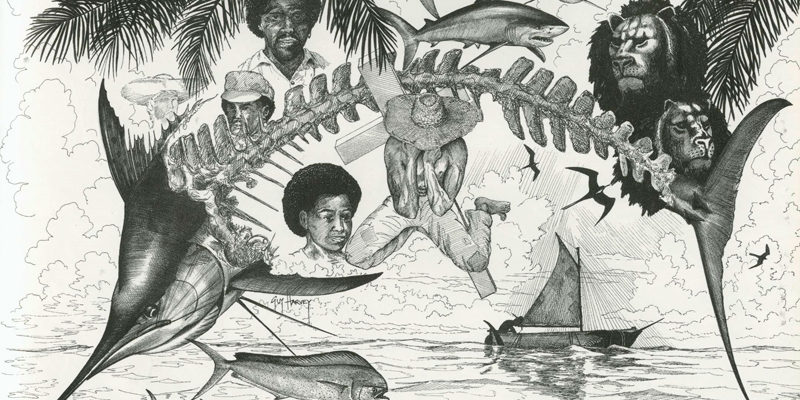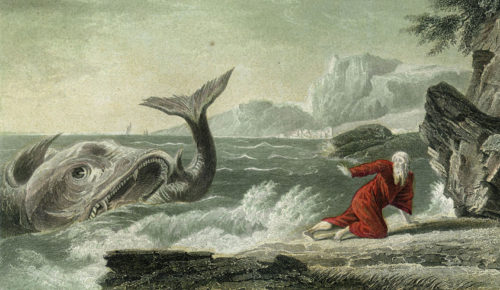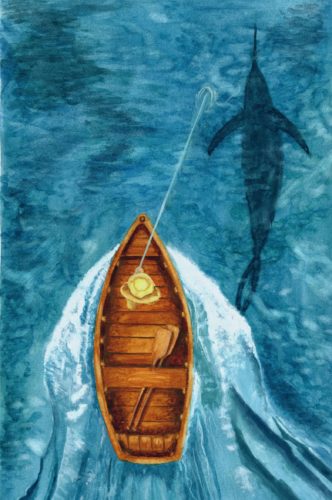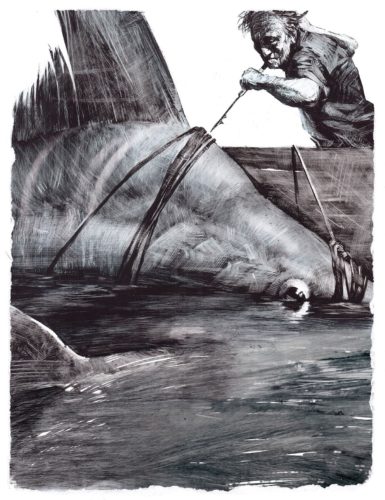
This post comes to us from Bror Erickson
The bones at the end of the “The Old Man and the Sea,” the skeleton of the big fish, always captures my attention as a strange metaphor for that empty tomb. What should be a symbol of failure signals the salvation of Santiago, the Old Man. So, I often end up reading Ernest Hemingway’s classic during the season of Easter because it makes for a fascinating resurrection story.
It is not without reason that this is Hemingway’s most famous literary work and credited with winning him the Nobel Prize in Literature. It is short and easily keeps a reader’s attention like any good fish story. However, the astute reader will notice rather quickly that the story is littered with religious language and metaphor while roughly following the outline of a biblical fish story found in the book of Jonah.
 Jesus gives the final interpretation concerning Jonah’s adventure with the big fish when he identifies it as a prophecy concerning his own death and resurrection: “Then some of the scribes and Pharisees answered him, saying this:
Jesus gives the final interpretation concerning Jonah’s adventure with the big fish when he identifies it as a prophecy concerning his own death and resurrection: “Then some of the scribes and Pharisees answered him, saying this:
“Teacher, we wish to see a sign from you.” But he answered them, “An evil and adulterous generation seeks for a sign, but no sign will be given to it except the sign of the prophet Jonah. For just as Jonah was three days and three nights in the belly of the great fish, so will the Son of Man be three days and three nights in the heart of the earth. The men of Nineveh will rise up at the judgment with this generation and condemn it, for they repented at the preaching of Jonah, and behold, something greater than Jonah is here.” (Matthew 12: 38-41)
Hemingway starts his novella with a crisis of faith on par with that of Jonah. The Old Man discusses his bad luck with a boy that looks after him like a devout disciple. The boy used to fish with the Old Man until his parents made him sign on with a different boat. The boy says of his father, “he hasn’t much faith.” The Old Man has been 84 days without a fish. The boy had stayed with him for the first 40 days. Now another 44 have passed. The boy feels sorry for the Old Man who has to face the hunger and thirst, like Jesus in the desert, all alone while he fishes in a skiff on the ocean. As a horse with no name is wont to remind us, the ocean is a desert. However, the boy recalls how they have been through this before, and the Old Man’s luck turned with the biggest fish they had ever caught.

True to form, the Old Man turns his luck the next day. Fishing further out to sea than is advisable for one man in a skiff, the Old Man catches his “big fish.” This time it is a marlin that takes him for a three-day Nantucket sleigh ride out to sea. The fish will not quit. The Old Man has to use all his wits and methodically exhaust his strength to reel in his catch.
Now the real struggle begins. The stage is set for Hemingway to work out another crisis of faith in the story. The Old Man says that he is not religious, but then, like Jonah occupying the belly of the fish, he begins the process of repentance. Santiago determines to pray ten Our Fathers and ten Hail Marys before promising to make a pilgrimage to the Virgin of Cobre (to whom Hemingway donated his Nobel Prize for Literature medal) if he manages to bring the fish in. He recites the prayers mechanically at first but gradually begins to add his own hopes and desires to them as appendages. The Old Man’s internal dialogue turns to the melancholic repentance of an old prizefighter looking back on a youth squandered gloriously sailing ships to the coast of Africa and arm wrestling in bayside bars.
At the same time, he pursues his present vanity and debates the justness of killing such a noble fish. Christians gathered about the Lord’s Supper can sympathize with the dialogue when the Old Man invests himself in the fish and asks, “How many people will he feed? But are they worthy to eat him?” The answer to the latter is a decided no on account of “behavior and great dignity.” Fishing line cuts stigmatic stripes into his back, but it will be through these stripes that the Old Man is healed when he finally triumphs over the fish.
A little while later, the seven last words of Christ are summed up with the word “Aye.” “Aye” Hemingway tells us, “has no translation.” It is just a noise “a man might make, involuntary, feeling the nail go through his hands and into the wood.” The Old Man’s crucifixion proves painful as shark after shark trails his return home. These least of all worthy creatures consume his catch and leave nothing but the skeleton.
The Old Man makes it home late at night. He leaves the boat with the fish skeleton still strapped to the side and goes to sleep on a bed of old newspapers. In the morning, his disciple the boy is there with coffee when he wakes. Faith is restored; the boy will begin to fish with the Old Man again. The bones have convinced him the old man’s luck is back. The skeleton of the fish has made the Old Man the talk of the town, the same way the empty tomb created buzz concerning Jesus.
It is a strange metaphor for an empty sepulcher, but perhaps no stranger than a large fish vomiting a man whole onto the beach. A skeleton is what we expect to find and do not find in Joseph of Arimathea’s tomb. Indeed, if we were to find a skeleton in the tomb, we would have to rethink our entire devotion to Jesus Christ. We would be most of all to be pitied. (1 Cor. 15:19) But that is the beauty of the analogy.

The empty bones floating in the surf point to a man’s triumphant return from the abyss. To him it is still failure. He caught the fish, and yet he failed to bring it in whole. The skeleton meant nothing for him, good for nothing but crab bait. Still there was salvation in the failure. The boy is there when the Old Man wakes from his sleep, a cup of coffee in place of the glass of water for the least of these my brothers. So, it often is for many of us that only in the face of failure do we find our true salvation. Only when we die does the kernel of wheat we sow bear fruit.

COMMENTS
2 responses to “The Resurrection in “The Old Man and the Sea””
Leave a Reply













Wow, bravo!
Beautiful stuff, Bror. Thank you.